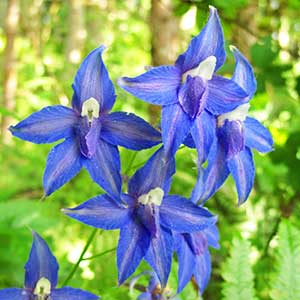Delphinium trolliifolium
Delphinium menziesii
Columbian larkspur, cow-poison, poison delphinium, poison larkspur
Menzies' larkspur
(40-)60-120(-180) cm;
base usually reddish, glabrous to puberulent.
(10-)35-70(-85) cm;
base often reddish, puberulent.
blade ± pentagonal, 4-8 × 7-16 cm, margins ± incised, nearly glabrous; ultimate lobes 0-9, width 15-30 mm (basal), 5-20 mm (cauline), widest at middle or in proximal 1/2.
blade round, 1.5-5 × 3-9 cm, puberulent; ultimate lobes 5-18, width 2-15 mm (basal), 1-10 mm (cauline), widest at middle or in proximal 1/2.
(5-)14-40(-75)-flowered, ± open, at least 2 times longer than wide;
pedicel 1-4(-9) cm, puberulent to glabrous;
bracteoles (2-)6-12 mm from flowers, green, linear, 5-9(-14) mm, puberulent.
3-15(-43)-flowered;
pedicel 1.5-4(-7) cm, (glandular) puberulent;
bracteoles 8-10(-24) mm from flowers, green to blue, linear, 4-6(-9) mm, puberulent.
sepals dark blue, glabrous, lateral sepals spreading, (8-)14-21 × 5-9 mm, spurs straight or downcurved at apex, within 20° of horizontal, (10-)16-23 mm;
lower petal blades covering stamens, 5-10 mm, clefts 1.5-3 mm;
hairs sparse, mostly near junction of blade and claw, centered or on inner lobes, well dispersed, yellow.
sepals bluish purple or yellowish, often partly fading upon drying, puberulent, lateral sepals spreading, (11-)13-20 × 5-11 mm, spurs straight, ascending less than 30° above horizontal, 11-17 mm;
lower petal blades ± covering stamens, 8-12 mm, clefts 0.2-2.5 mm;
hairs sparse, centered, mostly near junction of blade and claw above base of cleft, white or blue.
(15-)23-34 mm, 3.8-5.5 times longer than wide, glabrous.
11-17 mm, 3.5-4 times longer than wide, puberulent.
unwinged;
seed coats smooth.
wing-margined;
seed coat cell surfaces smooth, without swollen blunt hair.
= 16.
Delphinium trolliifolium
Delphinium menziesii
Delphinium trolliifolium occurs in the northern Coast Range of California, the Columbia River Valley to just east of Mt. Hood, and the Willamette Valley of Oregon upstream to Lane County. California plants differ somewhat from Oregon plants in pubescence patterns and habitat preferences. Further study may show that two entities are involved here.
Hybrids between Delphinium trolliifolium and D. decorum, D. menziesii subsp. pallidum (D. ×pavonaceum Ewan, Peacock larkspur), D. nudicaule, D. nuttallianum, and D. nuttallii are known. Delphinium trolliifolium is likely to be confused only with D. bakeri. Refer to discussion under that species for differences.
(Discussion copyrighted by Flora of North America; reprinted with permission.)
Subspecies 2 (2 in the flora).
Although Delphinium menziesii has often been confused with D. nuttallii, it may be distinguished by its consistently larger flowers and usually fewer flowers per plant. Interestingly, each species produces both blue-purple and yellowish flower colors in separate populations.
The Chehalis consider Delphinium menziesii poisonous, but they also apply it to sores. The women of the Thompson Indians use it as a love charm (D. E. Moerman 1986, subspecies not indicated).
(Discussion copyrighted by Flora of North America; reprinted with permission.)
1. Sepals blue to purple. | subsp. menziesii |
1. Sepals yellowish to white. | subsp. pallidum |


